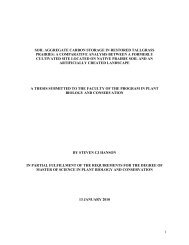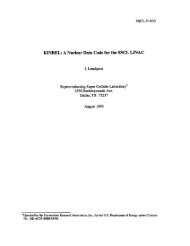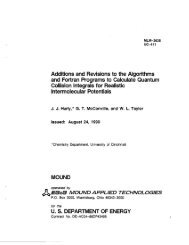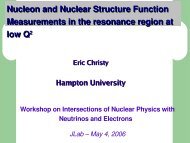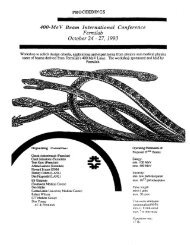Collective Acceleration Processes Using Waves on Electron Beams ...
Collective Acceleration Processes Using Waves on Electron Beams ...
Collective Acceleration Processes Using Waves on Electron Beams ...
Create successful ePaper yourself
Turn your PDF publications into a flip-book with our unique Google optimized e-Paper software.
Abstract<br />
<str<strong>on</strong>g>Collective</str<strong>on</strong>g> <str<strong>on</strong>g>Accelerati<strong>on</strong></str<strong>on</strong>g> <str<strong>on</strong>g>Processes</str<strong>on</strong>g> <str<strong>on</strong>g>Using</str<strong>on</strong>g> <str<strong>on</strong>g>Waves</str<strong>on</strong>g> <strong>on</strong> Electr<strong>on</strong> <strong>Beams</strong><br />
by<br />
John A. Nati<strong>on</strong><br />
School of Electrical Engineering and Laboratory of Plasma Studies<br />
Cornell University, Ithaca, N.Y. 14853<br />
We present, in this review, a summary of the various mechanisms which<br />
have been proposed for the accelerati<strong>on</strong> of electr<strong>on</strong>s and i<strong>on</strong>s in waves<br />
carried <strong>on</strong> electr<strong>on</strong> beams. This review attempts to highlight the physical<br />
processes occurring in these accelerators and, where appropriate, points<br />
out the clearly defined limits of applicability.<br />
Introducti<strong>on</strong><br />
In this paper we review the principles of collective accelerati<strong>on</strong>,<br />
using waves carried <strong>on</strong> an electr<strong>on</strong> beam, and briefly examine some of the<br />
limitati<strong>on</strong>s of this technique when applied to the generati<strong>on</strong> of ultra-high<br />
energy beams.<br />
The ,basic objective of collective accelerati<strong>on</strong> ;s to use a high<br />
current, moderate energy electr<strong>on</strong> beam to generate a lower current, high<br />
energy beam. A subsidiary requirement is that the accelerator be compact;<br />
that is, we maintain a high average field gradient throughout the acceler<br />
ator. Wave accelerators, such as those described below, form a subset of<br />
collective accelerators in which particle accelerati<strong>on</strong> is achieved by a<br />
two step process. Typically a wave is grown <strong>on</strong> an electr<strong>on</strong> beam by means<br />
of the interacti<strong>on</strong> between the electr<strong>on</strong> beam and some external structure,<br />
such as a disk loaded waveguide or a tape helix. The beam is extracted<br />
-115
from the wavegrowth regi<strong>on</strong> and injected into an inhomogeneous drift regi<strong>on</strong><br />
where the phase velocity of the wave is increased in a c<strong>on</strong>trolled fashi<strong>on</strong><br />
such that a particle initially trapped in the beam supported wave will<br />
c<strong>on</strong>tinue to be trapped and accelerated with the wave. From the point of<br />
view of the purist this does not c<strong>on</strong>stitute a true collective accelerator,<br />
since the waves and the particles would be self synchr<strong>on</strong>ized in such a<br />
device. It is probably true that if the maximum benefit is to be derived<br />
from a collective accelerator then the self synchr<strong>on</strong>izati<strong>on</strong> feature should<br />
be present. The approaches described in this paper do not have this<br />
feature and c<strong>on</strong>trol of the accelerati<strong>on</strong> gradient must be provided by<br />
external means.<br />
A number of variati<strong>on</strong>s of the wave accelerator have been suggested<br />
and some have been attempted experimentally, albeit at very low energies,<br />
in order to dem<strong>on</strong>strate the principle of the accelerator. In most cases<br />
the objective has been i<strong>on</strong> accelerati<strong>on</strong>, although in some cases the tech<br />
nique is equally applicable to electr<strong>on</strong> accelerati<strong>on</strong>. In the case of i<strong>on</strong><br />
accelerati<strong>on</strong> the-i<strong>on</strong>s are c<strong>on</strong>fined radially by the space charge fields of<br />
the unneutralized electr<strong>on</strong> beam which, in turn, is c<strong>on</strong>fined by a str<strong>on</strong>g<br />
axial magnetic field. For the electr<strong>on</strong> accelerator the applied magnetic<br />
field also c<strong>on</strong>fines the beam being accelerated to high energy.<br />
namely:<br />
There are two main regimes of interest for collective accelerati<strong>on</strong>,<br />
a. The particles being accelerated have a lower terminal velocity<br />
than the beam electr<strong>on</strong>s, and<br />
b. The particles being accelerated have a final velocity greater<br />
than that of the beam electr<strong>on</strong>s.<br />
In the former case we are usually c<strong>on</strong>cerned with i<strong>on</strong> accelerati<strong>on</strong> to a<br />
maximum energy equal to or less than the rest mass of the particle being<br />
accelerated, expressed in units of the electr<strong>on</strong> rest mass, times the
guide, since the electr<strong>on</strong>s will expand following the reducti<strong>on</strong> in the<br />
applied magnetic field. For the space charge wave the accelerati<strong>on</strong> pro<br />
cess requires an adiabatic chanqe in the electr<strong>on</strong> beam plasma frequency.<br />
This could also be achieved by an expansi<strong>on</strong> of the beam in a flaring guide<br />
and magnetic field, but the preferred method of decreasing the effective<br />
plasma frequency uses a slowly c<strong>on</strong>verging guide and a uniform externally<br />
applied axial magnetic field. This is preferred as it permits <strong>on</strong>e to<br />
retain a well defined c<strong>on</strong>stant radius electr<strong>on</strong> beam. This is clearly<br />
advantageous if staging is required for the electr<strong>on</strong> beam. The reducti<strong>on</strong><br />
in tube di ameter 1eads to a reducti<strong>on</strong> in the effecti ve pl asma frequency,<br />
since it leads to a greater number of field lines finishing <strong>on</strong> the tube<br />
wall. This increases the electromagnetic comp<strong>on</strong>ent of the wave. Alter<br />
nately it is evident that a reducti<strong>on</strong> in the tube size will lead to an<br />
increase in the perpendicular wave number. The successful implementati<strong>on</strong><br />
of a wave accelerator requires that at least four c<strong>on</strong>diti<strong>on</strong>s be satisfied:<br />
(i) Successful waveqrowth to the required amplitude,<br />
(ii) Adequate wave coherence, wave propagati<strong>on</strong> and phase velocity<br />
c<strong>on</strong>trol,<br />
(iii) Development of a suitable i<strong>on</strong> injector for the wave, and<br />
(iv) Successful trapping of the i<strong>on</strong>s.<br />
We now address each of these topics in somewhat greater detail.<br />
Wavegrowth<br />
The cyclotr<strong>on</strong> wave is essentially a TE mode and the space charge<br />
wave a TM mode. The art of growing these waves <strong>on</strong> beams is at a substan<br />
tially different level for the different modes. The cyclotr<strong>on</strong> mode has<br />
an axial r.f. magnetic field and therefore needs a structure such as a<br />
tape helix for its excitati<strong>on</strong>. Work has been carried out in both the<br />
U.S.A. and in the U.S.S.R. to investigate the qrowth of a slow cyclotr<strong>on</strong><br />
-120
wave. Most of this work is, as yet, unpublished. The required mode has<br />
been successfully grown <strong>on</strong> a low power, low enerqy, electr<strong>on</strong> beam 5<br />
although c<strong>on</strong>siderable difficulty has been experienced in the growth of the<br />
correct mode <strong>on</strong> a high power beam under c<strong>on</strong>diti<strong>on</strong>s when the beam tempera<br />
ture is sufficiently low. For higher temperature beams (greater spread in<br />
the transverse comp<strong>on</strong>ents of the beam energy) the excitati<strong>on</strong> is readily<br />
achieved but involves bootstrapping from an unwanted plasma oscillati<strong>on</strong><br />
mode.<br />
The excitati<strong>on</strong> of the slow space charqe wave is well developed and<br />
uses the self excitati<strong>on</strong> in disk loaded waveguides. 3 This same mode has<br />
been utilized in microwave systems for many years. C<strong>on</strong>current with the<br />
excitati<strong>on</strong> of the lowest order axially symmetric mode there is excitati<strong>on</strong><br />
of higher order axially symmetric modes. To date no effort has been made<br />
to suppress these unwanted modes as they have phase velocities well away<br />
from the particle velocities and have not interfered with the experiments<br />
in progress. Microwave tube technology exists which should permit sup<br />
pressi<strong>on</strong> of these modes if the need arises.<br />
Wave Coherence, Transport and Phase Velocity C<strong>on</strong>trol<br />
All experiments carried out to date have used short durati<strong>on</strong> pulses<br />
(-50-100 nsec.) and coherent waves, with bandwidths limited by the pulse<br />
durati<strong>on</strong>, have been observed over the complete pulse width. 6 Similarly<br />
measurements of the wave transport over the short experimental lengths<br />
used to date (3 m.) have not uncovered any great difficulties. The tech<br />
nique employed for the c<strong>on</strong>trol of the wave phase velocity is c<strong>on</strong>siderably<br />
simpler for the cyclotr<strong>on</strong> wave than that required for the space charqe<br />
wave. This arises mainly as the present test experiments are all carried<br />
out at very low wave phase velocities «0.2 c). In this reqime the space<br />
charge wave phase velocity changes extremely rapidly with the changing<br />
_101<br />
_
plasma frequency. In fact it has been shown analytically that the wave<br />
phase velocity <strong>on</strong>ly goes to zero when the beam current approaches its<br />
vacuum limit (set by space charge), and further <strong>on</strong>ly when the wave fre<br />
quency and wavenumber tend to zero. For practical purposes, in the linear<br />
regime, the wave phase velocity approaches a limit of order 0.2 c to<br />
0.25 c. For both waves, however, the phase velocity has been observed to<br />
change as predicted with changes in the cyclotr<strong>on</strong> (albeit in the presence<br />
of a simultaneously excited plasma wave) or effective plasma frequencies.<br />
There is, at present, an inadequate base to c<strong>on</strong>firm the wave velocity<br />
change in an actual accelerator geometry. All measurements have been<br />
made, to date, in homogeneous guides under varying shot to shot c<strong>on</strong>diti<strong>on</strong>s<br />
of the beam and field parameters. The change in wave parameters in an<br />
inhomogeneous guide or in a flaring magnetic field are not yet adequately<br />
c<strong>on</strong>firmed, although there is evidence to suggest that the dependence is<br />
correct in at least the c<strong>on</strong>verging guide space charge wave c<strong>on</strong>figurati<strong>on</strong>.<br />
I<strong>on</strong> Injecti<strong>on</strong> and Trapping<br />
For the purpose of dem<strong>on</strong>strati<strong>on</strong> of the proof of principle of slow<br />
wave accelerators an adequate source of ten MeV prot<strong>on</strong>s has been devel<br />
oped? and used in initial experiments <strong>on</strong> the slow space charge wave accel<br />
8 9<br />
erator.' Cyclotr<strong>on</strong> wave accelerator programs have not been reported at<br />
the level where i<strong>on</strong> injecti<strong>on</strong> was needed. In neither case has i<strong>on</strong> trap<br />
ping and accelerati<strong>on</strong> been reported although work is currently in progress<br />
<strong>on</strong> this topic. These topics have not been addressed from the point of<br />
view of high energy physics. Obviously adequate sources of high energy<br />
prot<strong>on</strong>s exist, although they are probably too weak to make full use of the<br />
high current capability of a collective accelerator.<br />
-122
(2) Beat Wave Accelerators<br />
An alternate class of collective accelerators using waves <strong>on</strong> beams<br />
rely <strong>on</strong> the n<strong>on</strong> linear interacti<strong>on</strong> between a modulated electr<strong>on</strong> beam and a<br />
quasi-periodic structure to generate a beat wave, which may be used to<br />
accelerate either i<strong>on</strong>s or electr<strong>on</strong>s. Two experimental c<strong>on</strong>figurati<strong>on</strong>s have<br />
been described in the published literature, namely modulated beam propaqa<br />
ti<strong>on</strong> through a rippled magnetic field, and modulated beam propagati<strong>on</strong><br />
through a waveguide having a rippled boundary. In both cases the beat<br />
wave phase velocity is c<strong>on</strong>trolled by a slow change in the period of the<br />
passive structure. This situati<strong>on</strong> is <strong>on</strong>e where a 'fast wave' interacti<strong>on</strong><br />
can be produced as the result of the beating of two slow waves. This<br />
situati<strong>on</strong> is extremely similar to that obtained in the plasma wave accelerator<br />
described elsewhere in these proceedings. 10<br />
In that case however,<br />
two waves each having a phase velocity greater than the speed of light,<br />
beat to produce a wave having a velocity less than the speed of light in<br />
vacuum. We now outline the underlying theory of the rippled wall beat<br />
wave accelerator. ll ,12<br />
C<strong>on</strong>sider a pencil beam propagating through a waveguide having a<br />
slowly varying radius R(z). If the beam current is I, the electr<strong>on</strong> veloc<br />
ity S c, and the beam radius r (assumed c<strong>on</strong>stant as the result of an<br />
applied uniform homogeneous guide magnetic field), then the potential <strong>on</strong><br />
axis may be expressed in the form 13<br />
.(z.t) = [e1cJ {l+2tr [¥]}·<br />
Expressing the boundary of the guide in the form<br />
and the modulated beam current as a travelling wave
wave. In this case the physics is essentially identical to that described<br />
above. He modulated the primary electr<strong>on</strong> beam using a series of coaxial<br />
cavities obtaining essentially a 100% modulati<strong>on</strong> of the beam. A counter<br />
streaming weaker electr<strong>on</strong> beam was fed into the rippled field structure<br />
coaxial with the primary beam. Unfortunately the two beams did not propa<br />
gate through each other so that the c<strong>on</strong>cept could not be tested. In this<br />
case this limitati<strong>on</strong> may well have arisen as the result of the potential<br />
depressi<strong>on</strong> <strong>on</strong> axis, due to the space charge in the primary and sec<strong>on</strong>dary<br />
beams exceeding the value causing virtual cathode formati<strong>on</strong>. N<strong>on</strong>e the<br />
less the c<strong>on</strong>cept seems sound and worth c<strong>on</strong>tinued investigati<strong>on</strong>.<br />
Applicati<strong>on</strong> to High Energy Physics Accelerators<br />
The use of slow waves for collective accelerati<strong>on</strong> implies that we are<br />
dealing with i<strong>on</strong> accelerators. In this applicati<strong>on</strong>, and for a sinqle<br />
stage accelerator, the i<strong>on</strong> energy is limited to<br />
M 2<br />
T =- (y -l)mc<br />
m e<br />
where Mand m represent the i<strong>on</strong> and electr<strong>on</strong> rest masses respectively, and<br />
Y e the relativistic factor for the electr<strong>on</strong>s in the primary electr<strong>on</strong> beam.<br />
This limit arises because the slow wave must propagate at a velocity not<br />
exceeding that of the electr<strong>on</strong>s in the primary beam. Based <strong>on</strong> present day<br />
technology for intense electr<strong>on</strong> beams this limit occurs at about 100 GeV.<br />
and would require the use of the ATA 15 accelerator. Since this is an<br />
inducti<strong>on</strong> linac machine the peak output energy limit of 50 MeV is not<br />
fundamental and could in principle be increased to an arbitrarily large<br />
value. The propagati<strong>on</strong> of the electr<strong>on</strong> beam through each accelerating<br />
cavity does cause some increase in the beam emittance. Limitati<strong>on</strong>s<br />
imposed by this process, for possible applicati<strong>on</strong> to i<strong>on</strong> accelerati<strong>on</strong>, are<br />
not known.
In practice <strong>on</strong>e need not be c<strong>on</strong>tent with a single stage accelerator,<br />
i.e. <strong>on</strong>e in which the i<strong>on</strong>s are c<strong>on</strong>tinually accelerated from low energy to<br />
their final energy, but can use a multi-stage accelerati<strong>on</strong> system. In<br />
such a device each stage would extend over a short distance, of order a<br />
few meters, and i<strong>on</strong> moti<strong>on</strong> would not be completely matched to the wave<br />
moti<strong>on</strong>. If the wave electric field is slightly too large to obtain exact<br />
phase matching between the i<strong>on</strong> and the wave, then a fracti<strong>on</strong>al wavelength<br />
slippage of the wave in a single secti<strong>on</strong> can be used to advantage. The<br />
slippage in <strong>on</strong>e stage can then be recovered at the start of the next<br />
stage. By this process the peak energy limitati<strong>on</strong> given above can be<br />
relaxed and applicati<strong>on</strong> of slow wave collective i<strong>on</strong> accelerati<strong>on</strong> to high<br />
energy accelerati<strong>on</strong> seems possible. This possibility is discussed in more<br />
detail by Denis Keefe 16 later in these proceedings.<br />
A questi<strong>on</strong> of some significance in the wave accelerator is the aver<br />
age field gradient which can be maintained. The useful limit <strong>on</strong> this<br />
would appear to be set by self trapping of the electr<strong>on</strong>s in the wave.<br />
This process starts at a field strength of order<br />
where<br />
and Yph is the relativistic factor appropriate to the wave velocity. a is<br />
a numerical factor which could be of order ten 2 • At low phase velocities<br />
this limit is unimportant and field strengths of several hundred MeV/m<br />
are possible. At high energy the self trapping field <strong>on</strong>set occurs at<br />
field strengths of order
2<br />
mc<br />
e<br />
This relati<strong>on</strong> implies, for high energy applicati<strong>on</strong>s, that we should<br />
work at high electr<strong>on</strong> kinetic energy and wave frequency, while maintaining<br />
Yph as low as possible c<strong>on</strong>sistent with being able to attain the final<br />
required energy. Detailed calculati<strong>on</strong>s of the phase slip per secti<strong>on</strong> per<br />
missible have not been performed. It is, however, of interest to specu<br />
late <strong>on</strong> wave parameters achievable at high energies. For the ATA electr<strong>on</strong><br />
beam Y = 100. At a wave Yph = 25 <strong>on</strong>e can maintain an electric field of<br />
e<br />
order 9xl0 7 Vim at a wave frequency of 206Hz. Electric fields within a<br />
factor of five of this have been achieved <strong>on</strong> a 5 MeV electr<strong>on</strong> beam, albeit<br />
in a propagating TE mode. It would be of interest to carefully calculate<br />
the minimum value of Yph needed for an ultra high energy machine and to<br />
determine if this is sufficiently low, when phase slippage per module is<br />
permitted, to allow <strong>on</strong>e to maintain the high average wave fields indicated<br />
above.<br />
The use of beat waves for accelerati<strong>on</strong> to high energy permits opera<br />
ti<strong>on</strong> in two regimes, namely the backward wave and the upper forward wave<br />
branches shown in figure 3. In either case <strong>on</strong>e generates a beat wave<br />
having an arbitrarily large velocity so that the limits described above<br />
for the slow waves are not applicable. In a beat wave accelerator <strong>on</strong>e can<br />
c<strong>on</strong>sider accelerati<strong>on</strong> of either prot<strong>on</strong>s or electr<strong>on</strong>s, and experiments are<br />
in progress trying to dem<strong>on</strong>strate accelerati<strong>on</strong> of both species of par<br />
ticle. Since the processes involved are inherently n<strong>on</strong> linear it is more<br />
difficult to obtain a realistic estimate of the potential of the beat wave<br />
system. In the absence of other n<strong>on</strong>-linear effects the accelerating<br />
electric field strength of the beat wave scales qualitatively as the<br />
product of the beam modulati<strong>on</strong> and the modulati<strong>on</strong> of the periodic<br />
-127
1<br />
1<br />
1<br />
,<br />
I<br />
I,<br />
I<br />
Backward<br />
wave<br />
Forward waves<br />
Fig. 3 Phase velocity of beat waves as a functi<strong>on</strong> of the period of the<br />
passive structure<br />
structure. In principle both of these can be made large and it would seem<br />
that field strengths comparable to the self fields of the beam are achiev<br />
able. Note that the self trapping limits indicated above should not be a<br />
serious problem in the beat wave accelerator because the phase velocity of<br />
the pump wave can be maintained well away from the electr<strong>on</strong> beam velocity.<br />
More theoretical analysis of these waves is needed in order to make a<br />
serious determinati<strong>on</strong> of their potential for applicati<strong>on</strong> to particle<br />
accelerators.<br />
C<strong>on</strong>clusi<strong>on</strong>s<br />
Wave accelerators based <strong>on</strong> the c<strong>on</strong>cepts outlined above hold some<br />
promise for applicati<strong>on</strong> to high energy physics. Basically they offer two<br />
advantages:<br />
(i) Average accelerating fields of order of the self fields of the beam<br />
are fairly readily achievable.<br />
(ii) The accelerating fields are located well away from the accelerator<br />
wall s.<br />
-128<br />
L
It is worth noting that wave accelerators, for high energy applica<br />
ti<strong>on</strong>s, operate in a regime well away from the vacuum space charge limiting<br />
current. This is important because it is in this regime that we know how<br />
to c<strong>on</strong>trol the beam. In additi<strong>on</strong> we do not require prohibitively large<br />
currents at high electr<strong>on</strong> beam energies.<br />
An interesting view of this type of collective accelerator arises if<br />
<strong>on</strong>e examines its similarity to a c<strong>on</strong>venti<strong>on</strong>al accelerator. As in the c<strong>on</strong><br />
venti<strong>on</strong>al case there are two beams, <strong>on</strong>e to generate the r.f. and the other<br />
c<strong>on</strong>sisting of the particles being accelerated. The collective regime<br />
represents a limiting case of the c<strong>on</strong>venti<strong>on</strong>al accelerator in the sense<br />
that the two beams overlap or at least are in close proximity to each<br />
other. This situati<strong>on</strong> should be compared with the c<strong>on</strong>venti<strong>on</strong>al situati<strong>on</strong><br />
in which the beams are well separated from each other. The close prox<br />
imity of the two beams offers the potential for significant gains in the<br />
coupling efficiency between the r.f. generati<strong>on</strong> and the beam accelerati<strong>on</strong>.<br />
In his introducti<strong>on</strong> to this c<strong>on</strong>ference Laws<strong>on</strong> 17 pointed out this distinc<br />
ti<strong>on</strong> as he categorized accelerator types. Keefe 16 and Tigner 18 have noted<br />
the possibilities for, and desirability of, greater coupling efficiency<br />
between the r.f. generati<strong>on</strong> and particle accelerati<strong>on</strong> phases of an<br />
accelerator.<br />
References<br />
1. M.L. Sloan and W.E. Drumm<strong>on</strong>d: Physo Rev. Lp.tt. IL, 1234 (1973)<br />
2. P. Sprangle, A.T. Drobot, and W.H. Manheimer: Phys. Rev. Lett. 36,<br />
1180 (1976)<br />
3. G. Gammel, J.A. Nati<strong>on</strong>, M. Read: J. Appl. Phys. 50, 5603 (1979)<br />
4. S.V. Yadavalli: Appl. Phys. Lett. 29,272 (1976)<br />
5. B. Ivanov, B. Goroznanin, Proc. 3rd Int. Topical C<strong>on</strong>f. <strong>on</strong> High Power<br />
Electr<strong>on</strong> and I<strong>on</strong> Beam Research and Technology, vol. I, 327 (1979)



